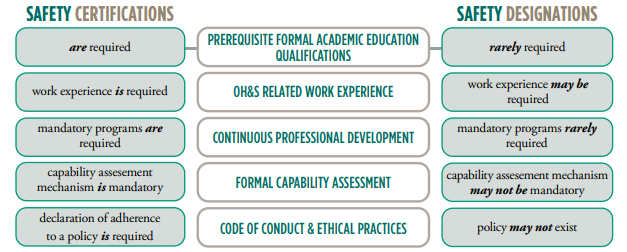Updated December 2025
In the occupational health and safety (OHS) field, getting certified by a respected organization proves your skills and opens up more job opportunities.
But navigating all the different credentials available in Canada can be really challenging.
If you’re considering alternatives to a four-year health and safety degree, you may be looking into college-level health and safety programs. In this case, understanding your path to certification is crucial.
Some health and safety employers prefer to hire candidates with university degrees. However, many companies will consider applicants with a college diploma, provided they’ve also earned a health and safety certification or designation. (As you will learn, these are not the same thing.)
In this post, we take you through popular safety certifications and designations that do not require a university degree.
Compare requirements for each credential and learn more about your career options in OHS.
What’s the difference between a certification and a designation?
Before you start exploring your options, it's important to know that a health and safety certification is NOT the same as a health and safety designation.
What's the difference? It boils down to requirements.
Certifications are generally harder to earn. They often have tougher educational requirements, examinations, and strict professional obligations (like a code of conduct you must follow).
In its official Guide to OH&S Certifications and Designations, the Canadian Society of Safety Engineering (CSSE) uses this chart to break down the differences.
Safety Certifications versus Safety Designations

Source: CSSE Guide to OH&S Certifications & Designations
The bottom line: Health and safety certifications often have stricter academic and professional requirements than designations. But that doesn’t mean valid designations are not respected.
Canada offers several nationally recognized, valuable certifications and designations in the field of OHS. Read on for some of the most well-known credentials.
Canadian Registered Safety Technician (CRST) certification
The Canadian Registered Safety Technician (CRST) certification is delivered by the Board of Canadian Registered Safety Professionals (BCRSP).
The BCRSP is a not-for-profit organization that sets high standards for health and safety training and professional practice.
The CRST is an entry-level certification, ideal for newcomers to the industry. You do not need a university degree to qualify.
There are a few different training pathways to becoming a CRST. But generally speaking, you must:
☑️ Complete a health and safety certificate or diploma program
☑️ Get 12 months of real work experience in a health and safety role
☑️ Pass the CRST exam
☑️ Adhere to the BCRSP Code of Conduct
☑️ Take mandatory professional development programs
Important: If you complete a health and safety program that is approved by the BCRSP, the experience requirement is waived. That means you can earn this certification faster.
For example, Herzing’s Occupational Health and Safety program is BCRSP-approved. Our students can write the certification exam right after graduating, and if successful, enter the workforce as Canadian Registered Safety Technicians.
As a CRST, you are a stronger candidate for jobs and have the potential to earn more money.
Canadian Registered Safety Professional (CRSP) certification
The Canadian Registered Safety Professional (CRSP) certification is also offered by the Board of Canadian Registered Safety Professionals. This is the next level of certification after the CRST.
To become a CRSP, you need at least four years of work experience in a health and safety role.
General requirements include:
☑️ Completing a health and safety degree or diploma program
☑️ Obtaining at least four years of health and safety work experience
☑️ Passing the CRSP examination
☑️ Adhering to the BCRSP Code of Conduct
☑️ Taking mandatory professional development programs
The CRSP is considered the gold standard for health and safety professionals. This certification is respected across Canada and required for most leadership OHS positions.
The key here is real work experience. Earning your CRSP certification proves you have the knowledge and real-world skills needed to manage a health and safety program at any company.
Once you earn your CRST, you can begin working toward the CRSP certification. Graduates of approved training programs (such as Herzing) are eligible for the CRSP after completing the required years of work experience.
Certified Health and Safety Consultant (CHSC)
The Certified Health and Safety Consultant (CHSC) certification is offered by the Canadian Society of Safety Engineering (CSSE).
OHS consultants don’t work for one single company. Instead, they offer a range of services to various companies, including risk assessments, safety audits, and safety policies and procedures implementation.
You don’t necessarily need a university degree to qualify for this certification. General requirements to become a CHSC include:
☑️ Completing a health and safety diploma or certificate
☑️ Obtaining five years of work experience as a safety advisor or consultant
☑️ Completing six courses (delivered by the CSSE) with a minimum passing grade of 75 per cent
☑️ Becoming a member of the CSSE
Attracted to a career as an independent consultant? Like the idea of working with a variety of different companies and organizations?
You can start your path toward certification with a one-year diploma in health and safety.
National Construction Safety Officer (NCSO) Designation
Have a background in construction and want to move into a health and safety role? You could be an ideal candidate for the National Construction Safety Officer (NCSO) designation.
This designation is for general labourers or tradespeople who have experience in construction combined with health and safety training. It’s delivered by the Canadian Federation of Construction Safety Associations (CFCSA), which has affiliates in each province.
A construction safety officer plays a key role in reducing accidents, injuries, and deaths on building sites. To qualify, you must complete some training courses, exams, and other requirements with your provincial affiliate.
For example, if you live in Ontario, you must:
☑️ Submit a resume that proves your experience in the construction industry
☑️ Complete the required NCSO training courses
☑️ Perform a simulated workplace assessment
☑️ Pass national and provincial exams
☑️ Sign a code of ethics
☑️ Verify your NCSO designation every 3 years
Once you earn your NCSO designation, you will be qualified to serve as a COR™ Internal Auditor and Construction Health and Safety Representative.
Many construction companies prefer to hire applicants who understand COR™ auditing principles, and have earned a safety designation or certificate.
Important: After five years of work experience, NCSO professionals are automatically eligible to write the Gold Seal exam. Once you pass the exam, you become a Gold Seal Certified Construction Safety Coordinator.
This credential proves you have advanced skills in construction safety and is recognized across Canada.
Get started with occupational health and safety training
Your path toward a successful career in OHS begins with quality health and safety training. If you don’t want to pursue a university degree, there are several college-level certificates and diplomas to choose from.
Quality programs are approved by major certifying organizations, like the Board of Canadian Registered Safety Professionals. There are one- to two-year programs, and even options for online health and safety training.
Important: If you are interested in one of the safety certifications or designations covered here, ask the college if their OHS program meets educational requirements for that credential.
Graduating from a recognized, approved training program can fast-track your path to certification and help you qualify for more jobs.
Have questions? Explore the Occupational Health and Safety training from Herzing College. It takes just 12 months to complete and includes an internship for real work experience.
Click below to learn more, or chat live with an admissions advisor. Ask about certification, OHS careers, financial aid, course schedules, or how to apply. We’re here to help!








